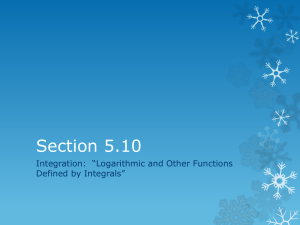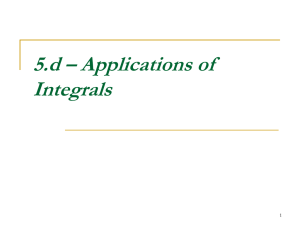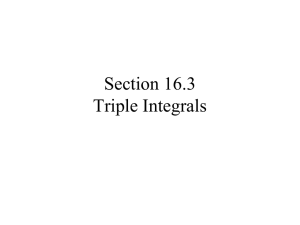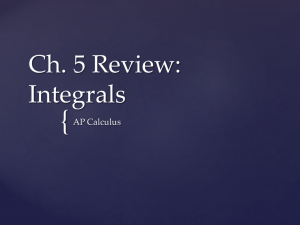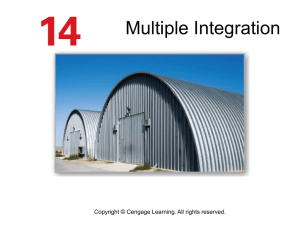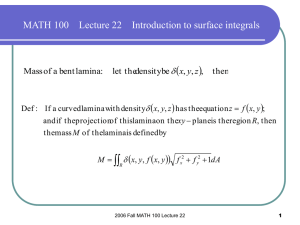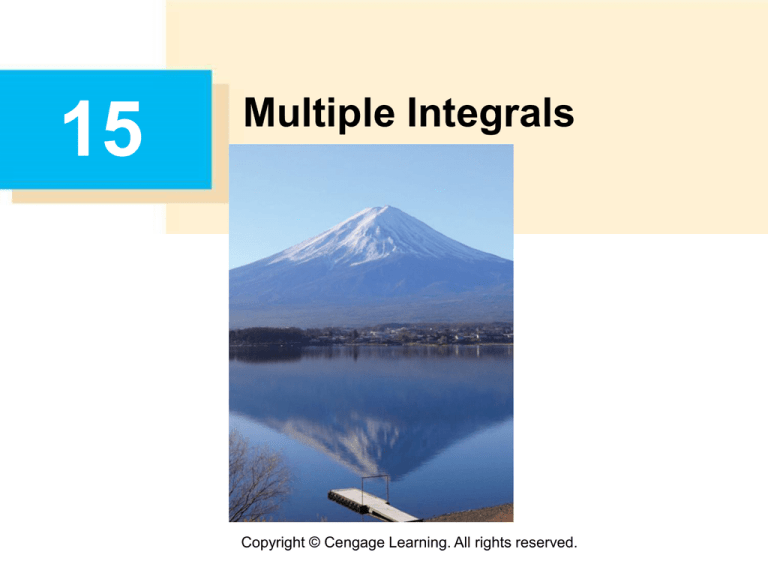
15
Multiple Integrals
Copyright © Cengage Learning. All rights reserved.
15.3
Double Integrals over General Regions
Copyright © Cengage Learning. All rights reserved.
Double Integrals over General Regions
For single integrals, the region over which we integrate is
always an interval.
But for double integrals, we want to be able to integrate a
function f not just over rectangles but also over regions D of
more general shape, such as the one illustrated in Figure 1.
Figure 1
3
Double Integrals over General Regions
We suppose that D is a bounded region, which means that
D can be enclosed in a rectangular region R as in Figure 2.
Figure 2
Then we define a new function F with domain R by
4
Double Integrals over General Regions
If F is integrable over R, then we define the double
integral of f over D by
Definition 2 makes sense because R is a rectangle and so
R F(x, y) dA has been previously defined.
5
Double Integrals over General Regions
The procedure that we have used is reasonable because
the values of F(x, y) are 0 when (x, y) lies outside D and so
they contribute nothing to the integral.
This means that it doesn’t matter what rectangle R we use
as long as it contains D.
In the case where f(x, y) 0, we can still interpret
D f(x, y) dA as the volume of the solid that lies above D
and under the surface z = f(x, y) (the graph of f).
6
Double Integrals over General Regions
You can see that this is reasonable by comparing the
graphs of f and F in Figures 3 and 4 and remembering that
R F(x, y) dA is the volume under the graph of F.
Figure 3
Figure 4
7
Double Integrals over General Regions
Figure 4 also shows that F is likely to have discontinuities
at the boundary points of D.
Nonetheless, if f is continuous on D and the boundary
curve of D is “well behaved”, then it can be shown that
R F(x, y) dA exists and therefore D f(x, y) dA exists.
In particular, this is the case for type I and type II regions.
8
Double Integrals over General Regions
A plane region D is said to be of type I if it lies between the
graphs of two continuous functions of x, that is,
D = {(x, y) | a x b, g1 (x) y g2 (x)}
where g1 and g2 are continuous on [a, b]. Some examples
of type I regions are shown in Figure 5.
Figure 5
Some type I regions
9
Double Integrals over General Regions
In order to evaluate D f(x, y) dA when D is a region of
type I, we choose a rectangle R = [a, b] [c, d] that
contains D, as in Figure 6, and we let F be the function
given by Equation 1; that is, F agrees with f on D and F is 0
outside D.
Figure 6
10
Double Integrals over General Regions
Then, by Fubini’s Theorem,
Observe that F(x, y) = 0 if y < g1 (x) or y > g2(x) because
(x, y) then lies outside D. Therefore
because F(x, y) = f(x, y) when g1 (x) y g2 (x).
11
Double Integrals over General Regions
Thus we have the following formula that enables us to
evaluate the double integral as an iterated integral.
The integral on the right side of
is an iterated integral,
except that in the inner integral we regard x as being
constant not only in f(x, y) but also in the limits of
integration, g1 (x) and g2 (x).
12
Double Integrals over General Regions
We also consider plane regions of type II, which can be
expressed as
D = {(x, y) | c y d, h1(y) x h2(y)}
where h1 and h2 are continuous. Two such regions are
illustrated in Figure 7.
Figure 7
Some type II regions
13
Double Integrals over General Regions
Using the same methods that were used in establishing
we can show that
,
14
Example 1
Evaluate D (x + 2y) dA, where D is the region bounded by
the parabolas y = 2x2 and y = 1 + x2.
Solution:
The parabolas intersect when 2x2 = 1 + x2, that is, x2 = 1,
so x = 1.
We note that the region D,
sketched in Figure 8, is a
type I region but not a type II
region and we can write
D = {(x, y) | –1 x 1, 2x2 y 1 + x2}
Figure 8
15
Example 1 – Solution
cont’d
Since the lower boundary is y = 2x2 and the upper
boundary is y = 1 + x2, Equation 3 gives
16
Example 1 – Solution
cont’d
17
Properties of Double Integrals
18
Properties of Double Integrals
We assume that all of the following integrals exist. The first
three properties of double integrals over a region D follow
immediately from Definition 2.
If f(x, y) g(x, y) for all (x, y) in D, then
19
Properties of Double Integrals
The next property of double integrals is similar to the
property of single integrals given by the equation
If D = D1 U D2, where D1 and D2
don’t overlap except perhaps on
their boundaries (see Figure 17),
then
Figure 17
20
Properties of Double Integrals
Property 9 can be used to evaluate double integrals over
regions D that are neither type I nor type II but can be
expressed as a union of regions of type I or type II.
Figure 18 illustrates this procedure.
D is neither type I nor type II.
D = D1 D2, D1 is type I, D2 is type II.
Figure 18(a)
Figure 18(b)
21
Properties of Double Integrals
The next property of integrals says that if we integrate the
constant function f(x, y) = 1 over a region D, we get the
area of D:
22
Properties of Double Integrals
Figure 19 illustrates why Equation 10 is true: A solid
cylinder whose base is D and whose height is 1 has
volume A(D) 1 = A(D), but we know that we can also write
its volume as D 1 dA.
Figure 19
Cylinder with base D and height 1
23
Properties of Double Integrals
Finally, we can combine Properties 7, 8, and 10 to prove
the following property.
24
Example 6
Use Property 11 to estimate the integral D esin x cos y dA,
where D is the disk with center the origin and radius 2.
Solution:
Since –1 sin x 1 and –1 cos y 1, we have
–1 sin x cos y 1 and therefore
e–1 esin x cos y e1 = e
Thus, using m = e–1 = 1/e, M = e, and A(D) = (2)2 in
Property 11, we obtain
25

